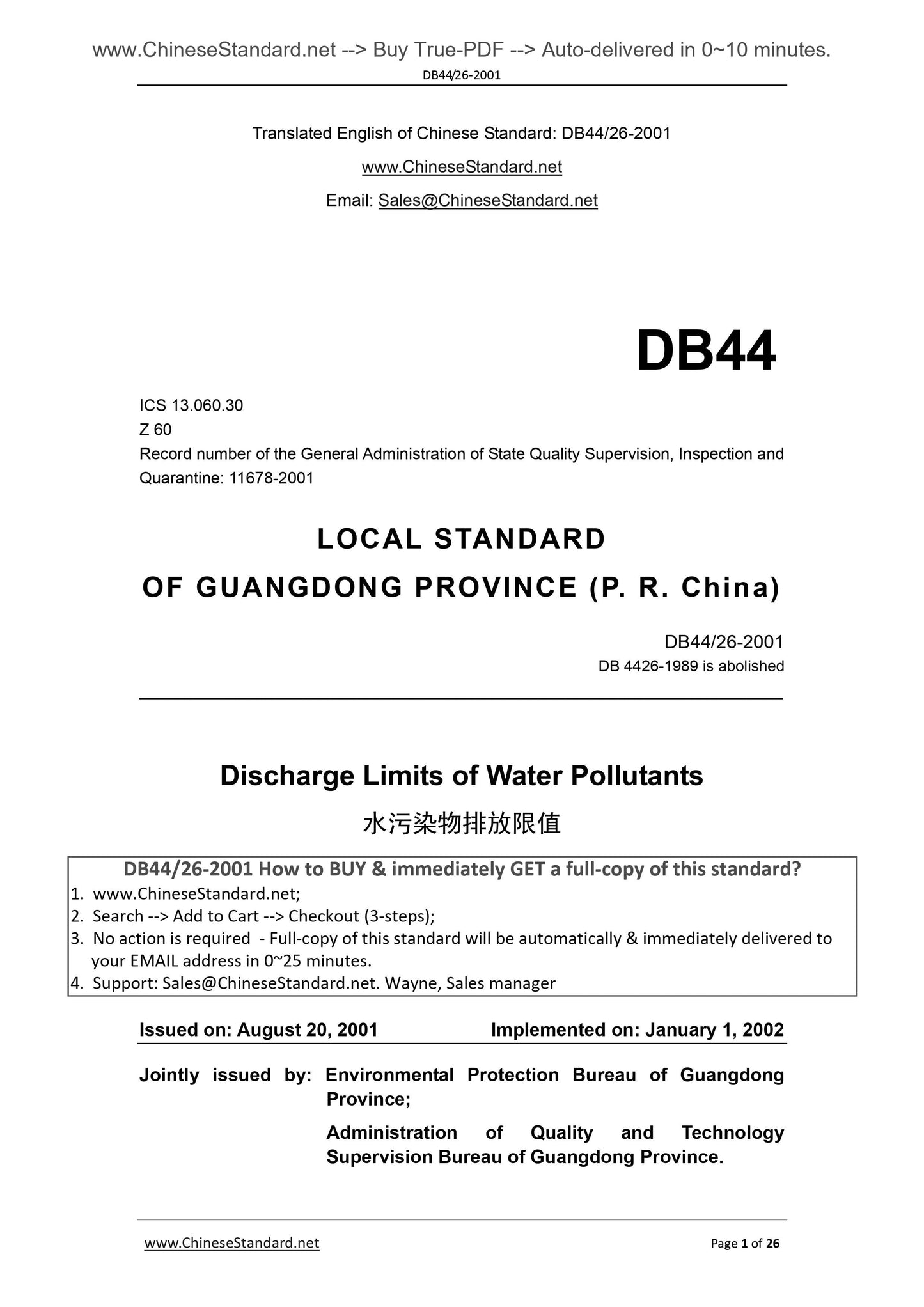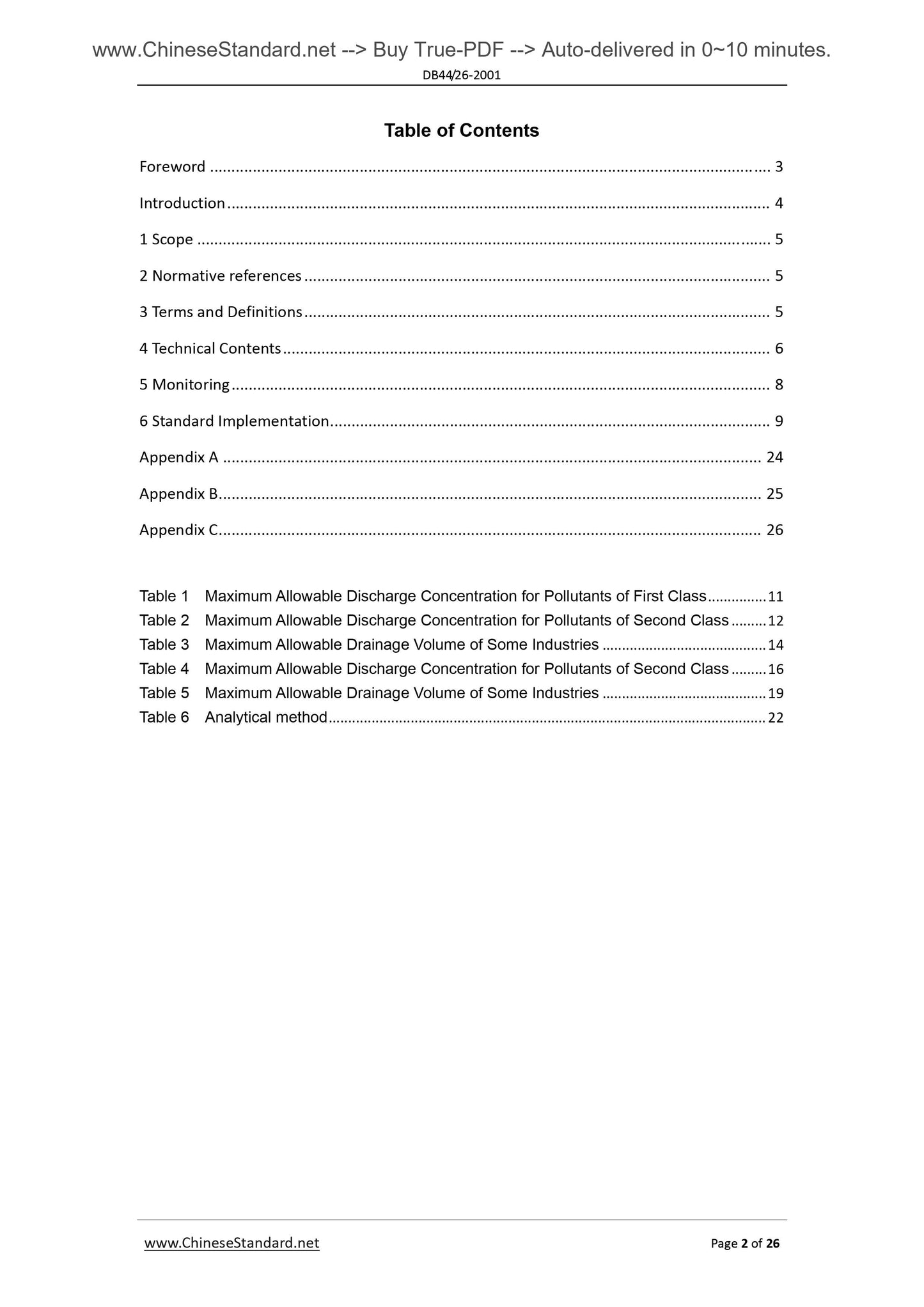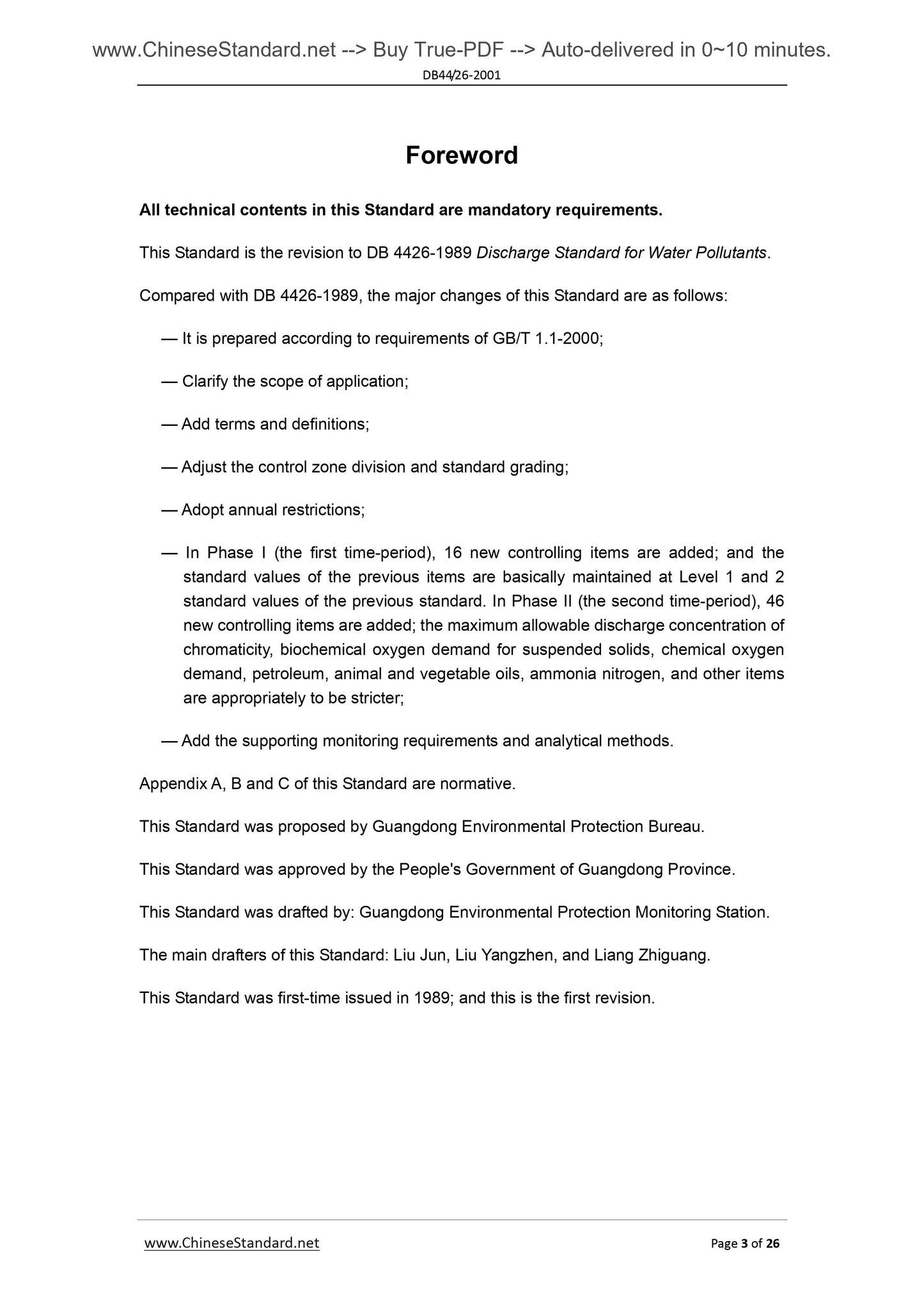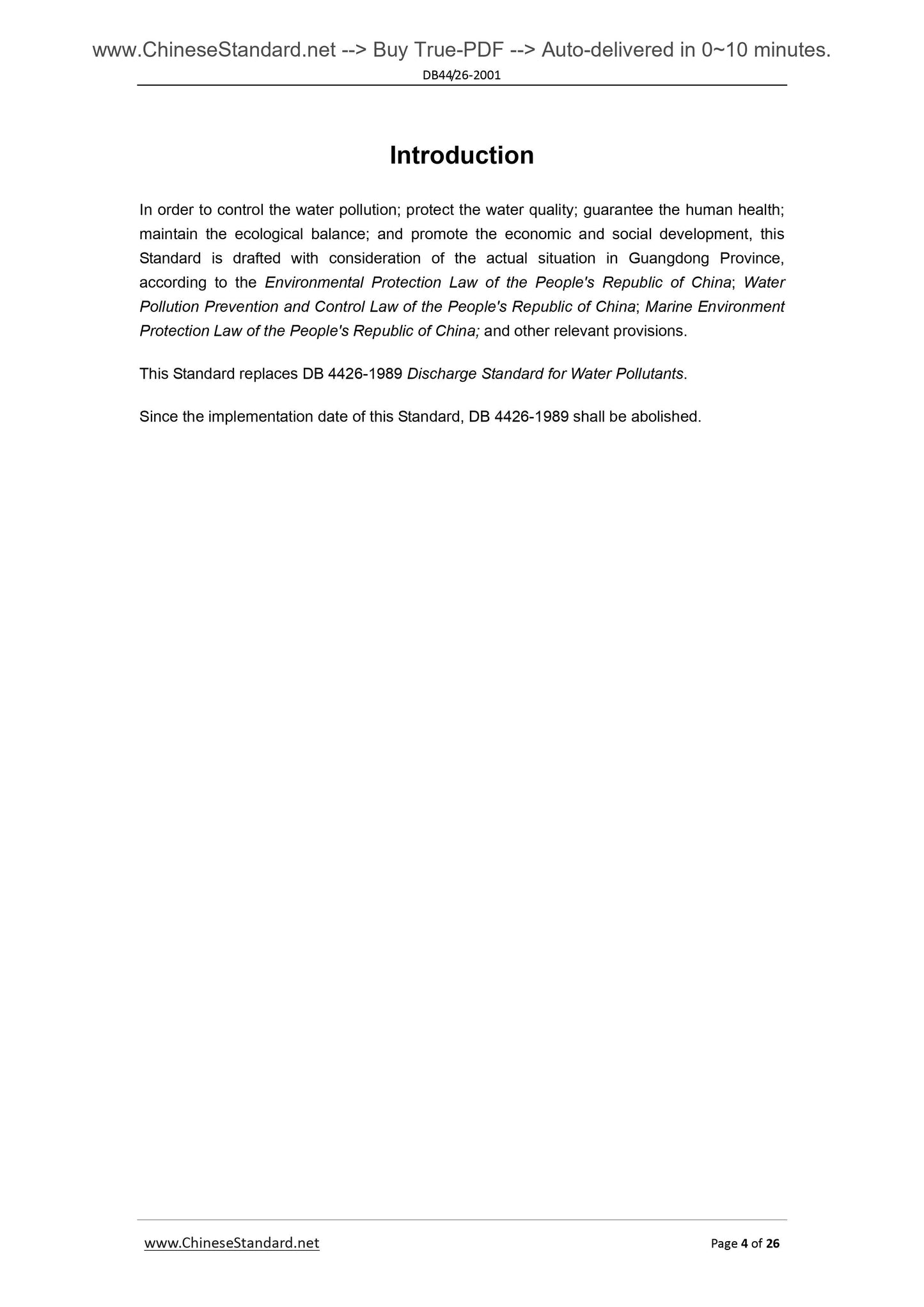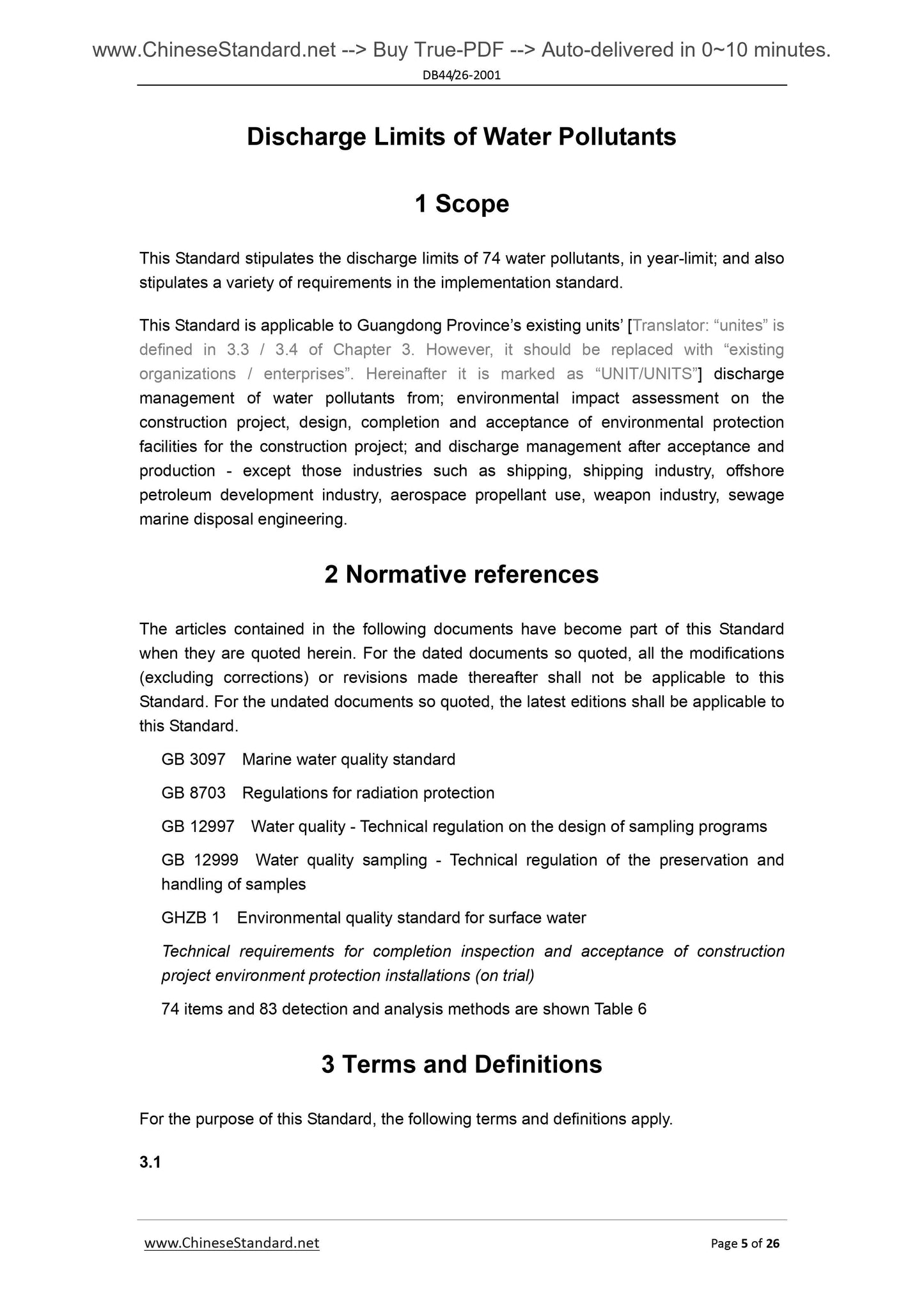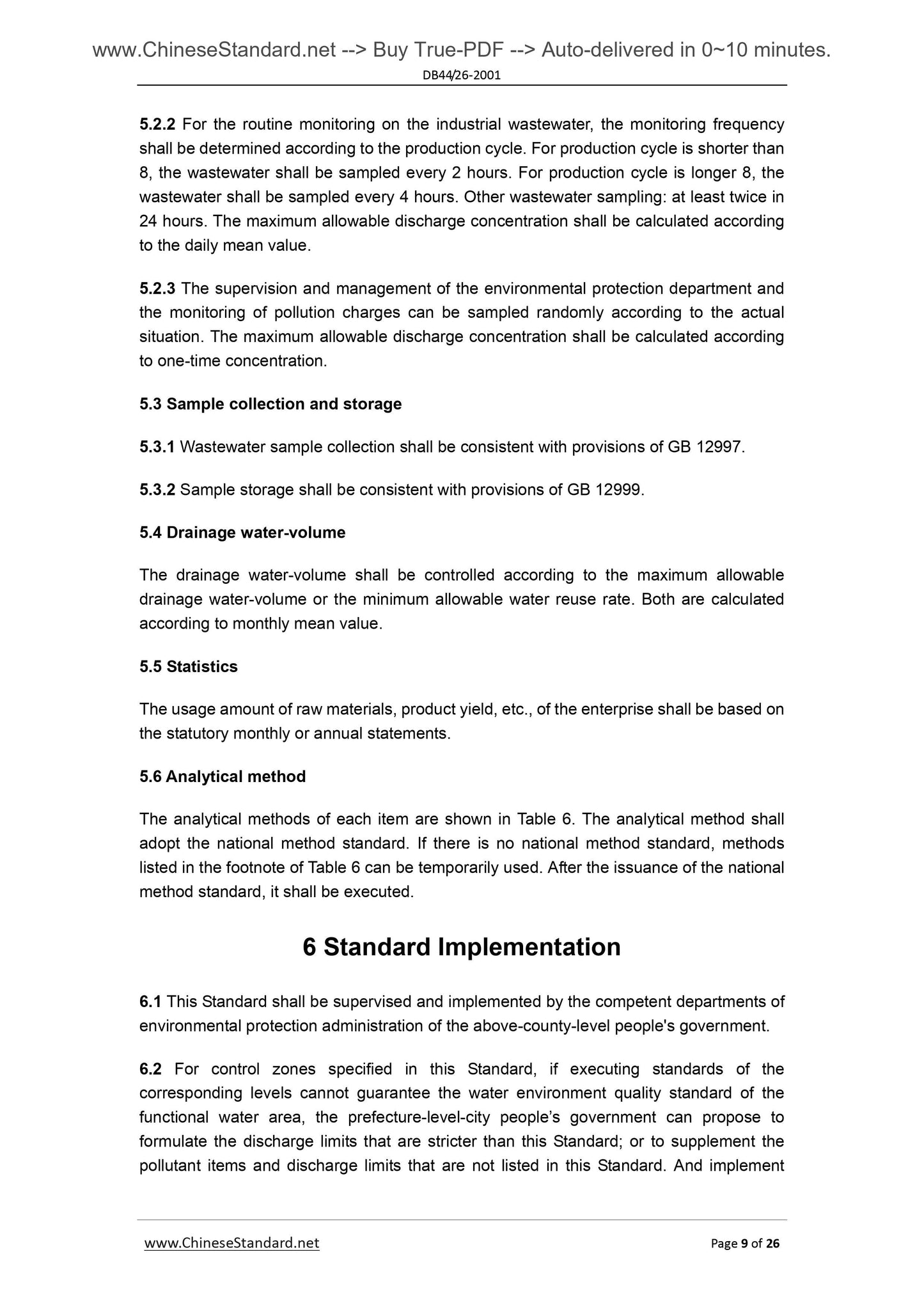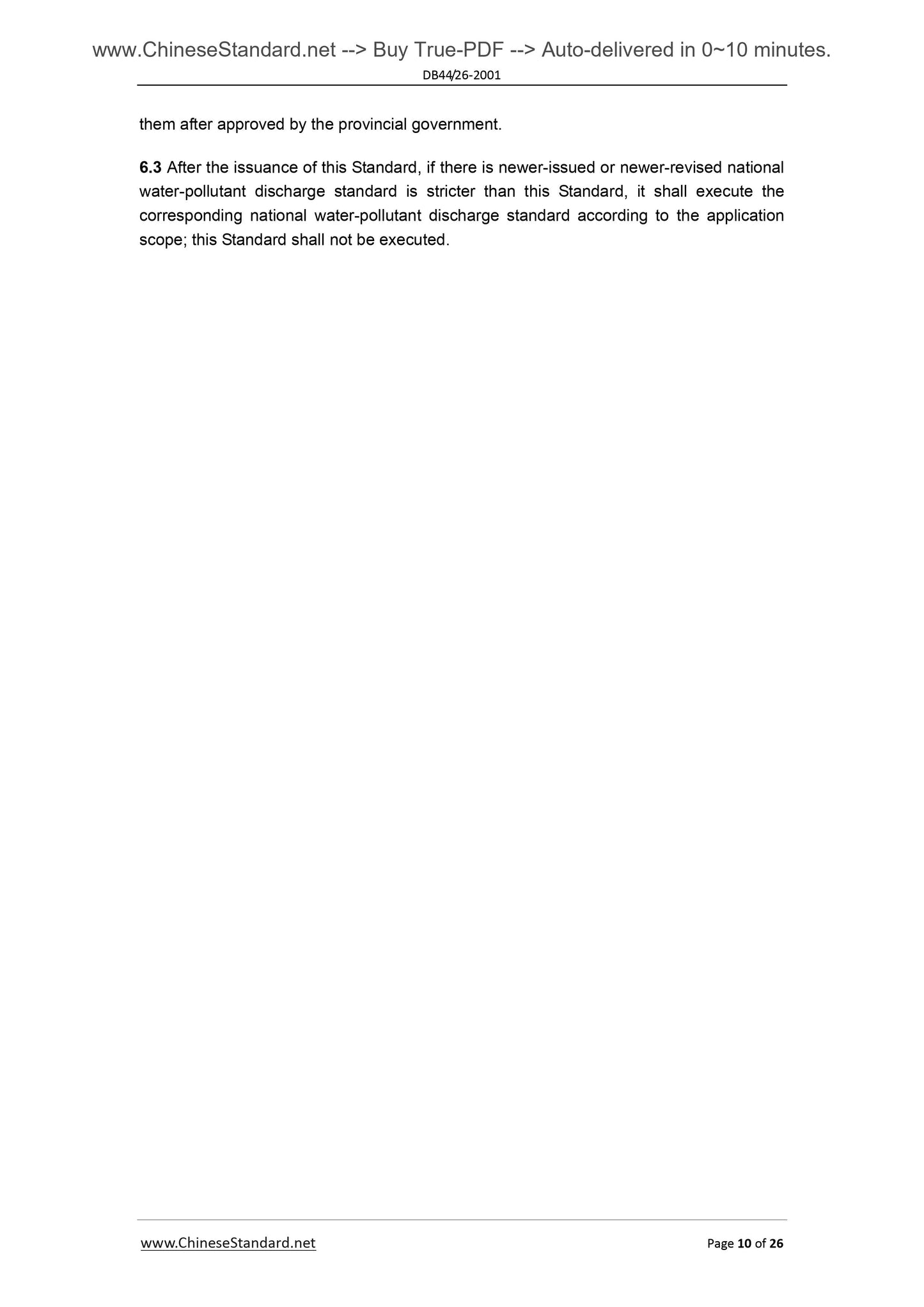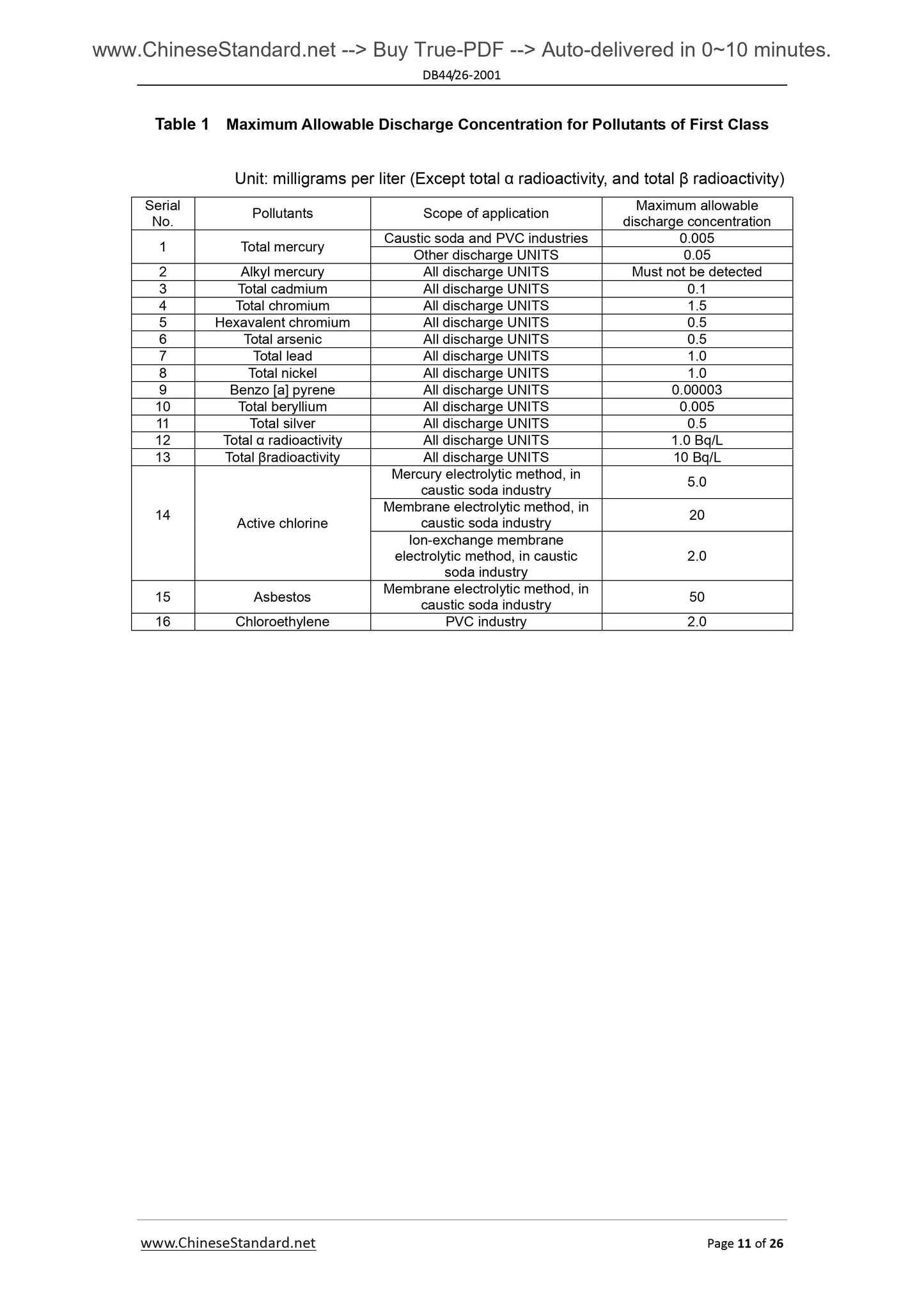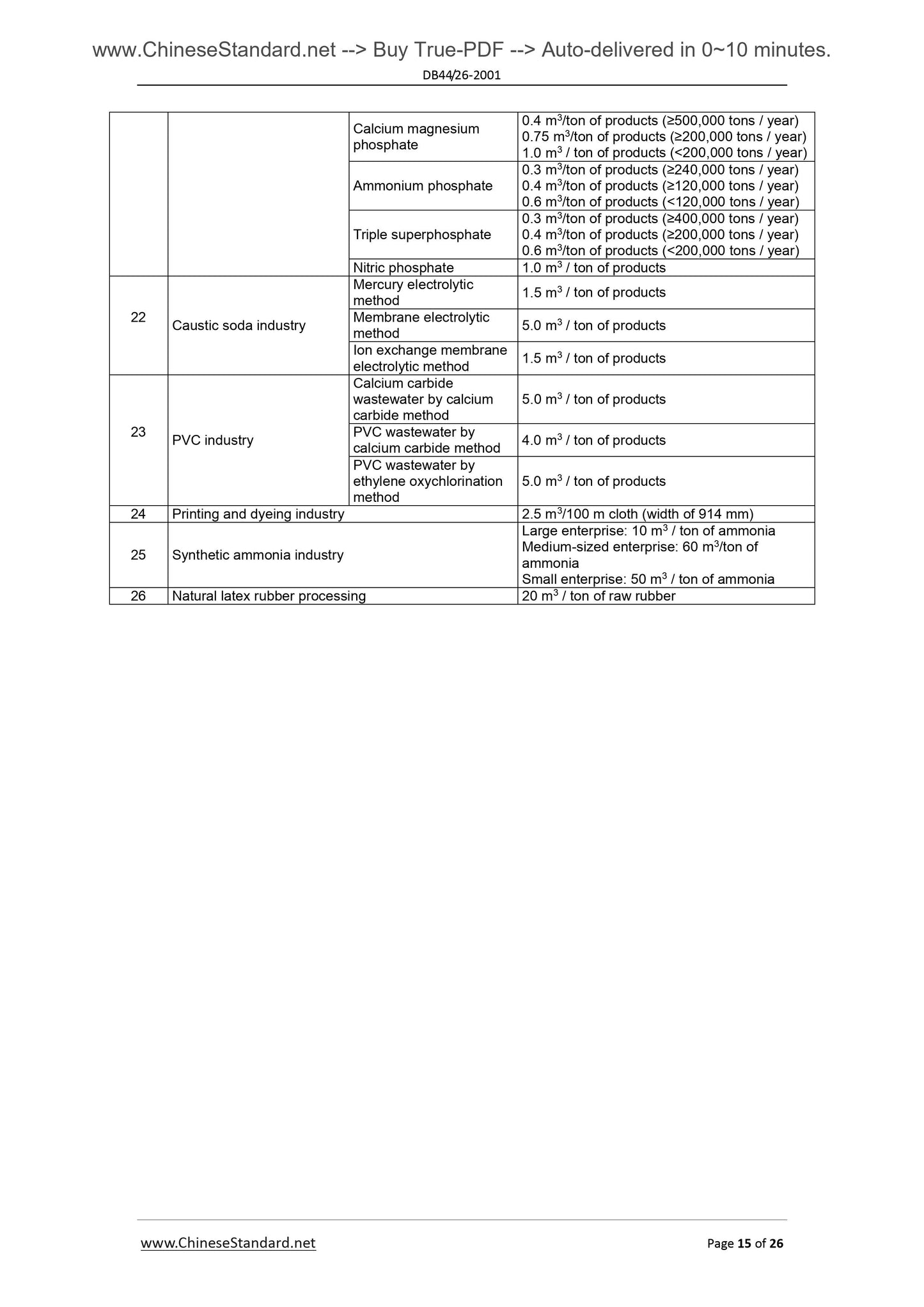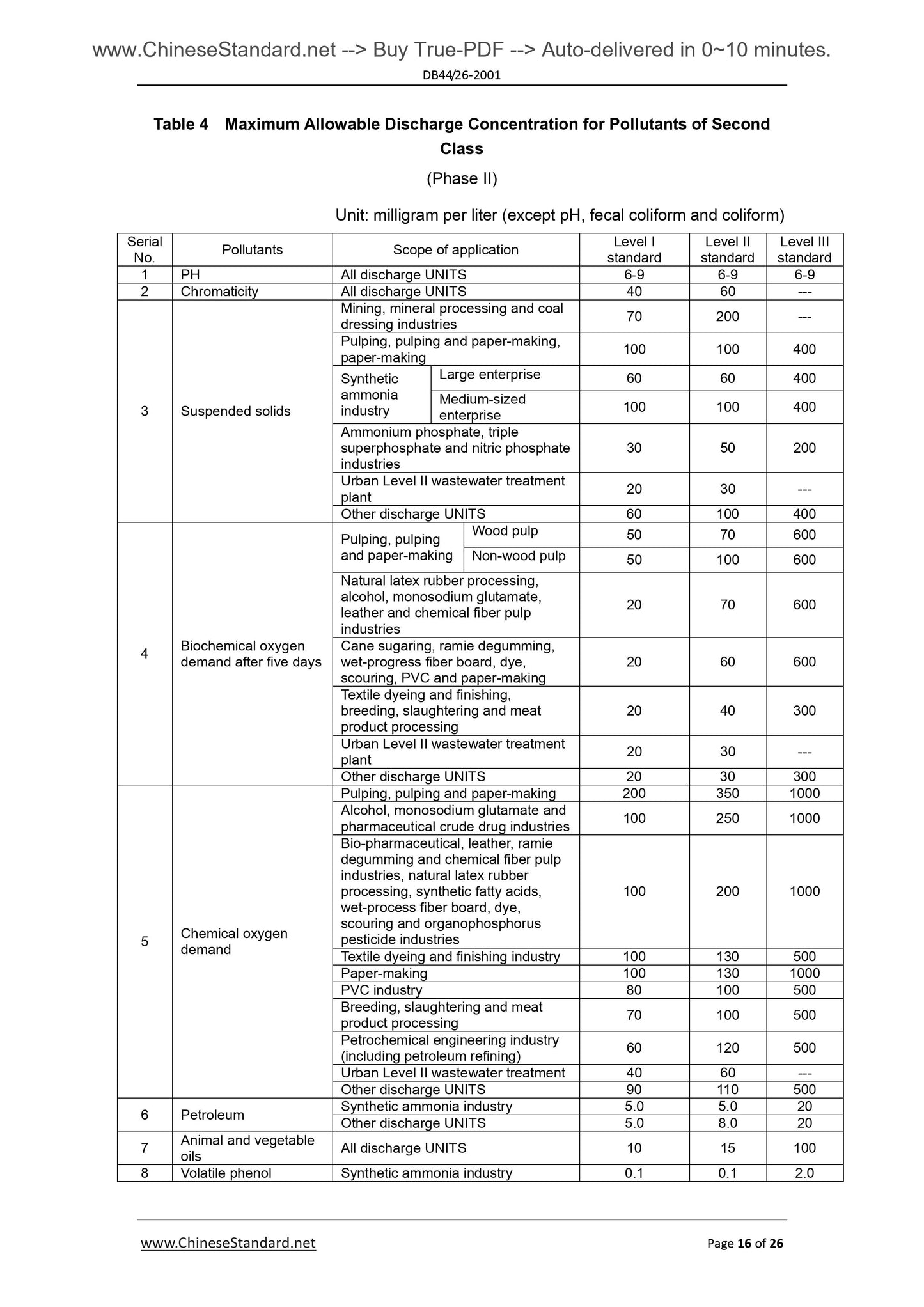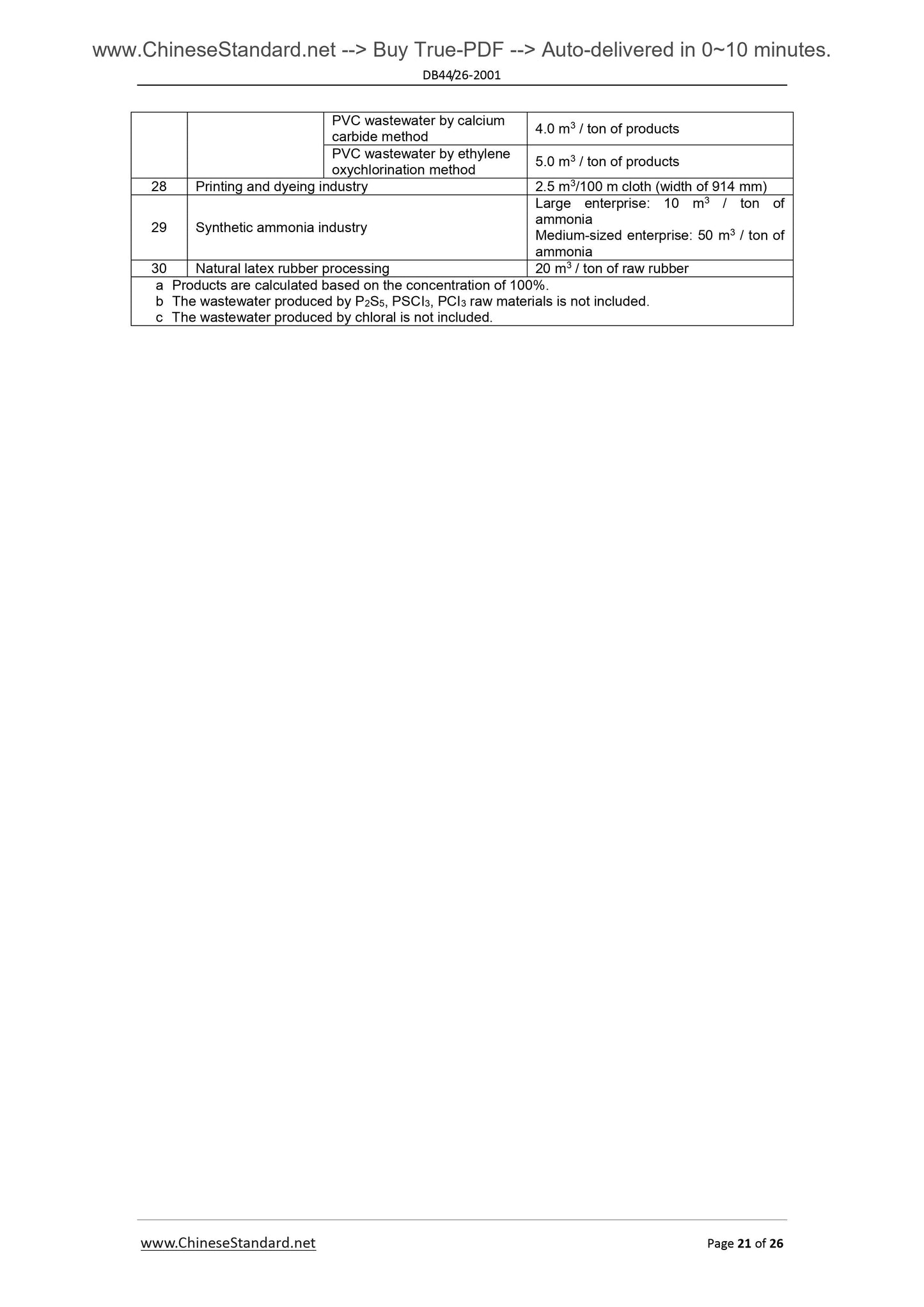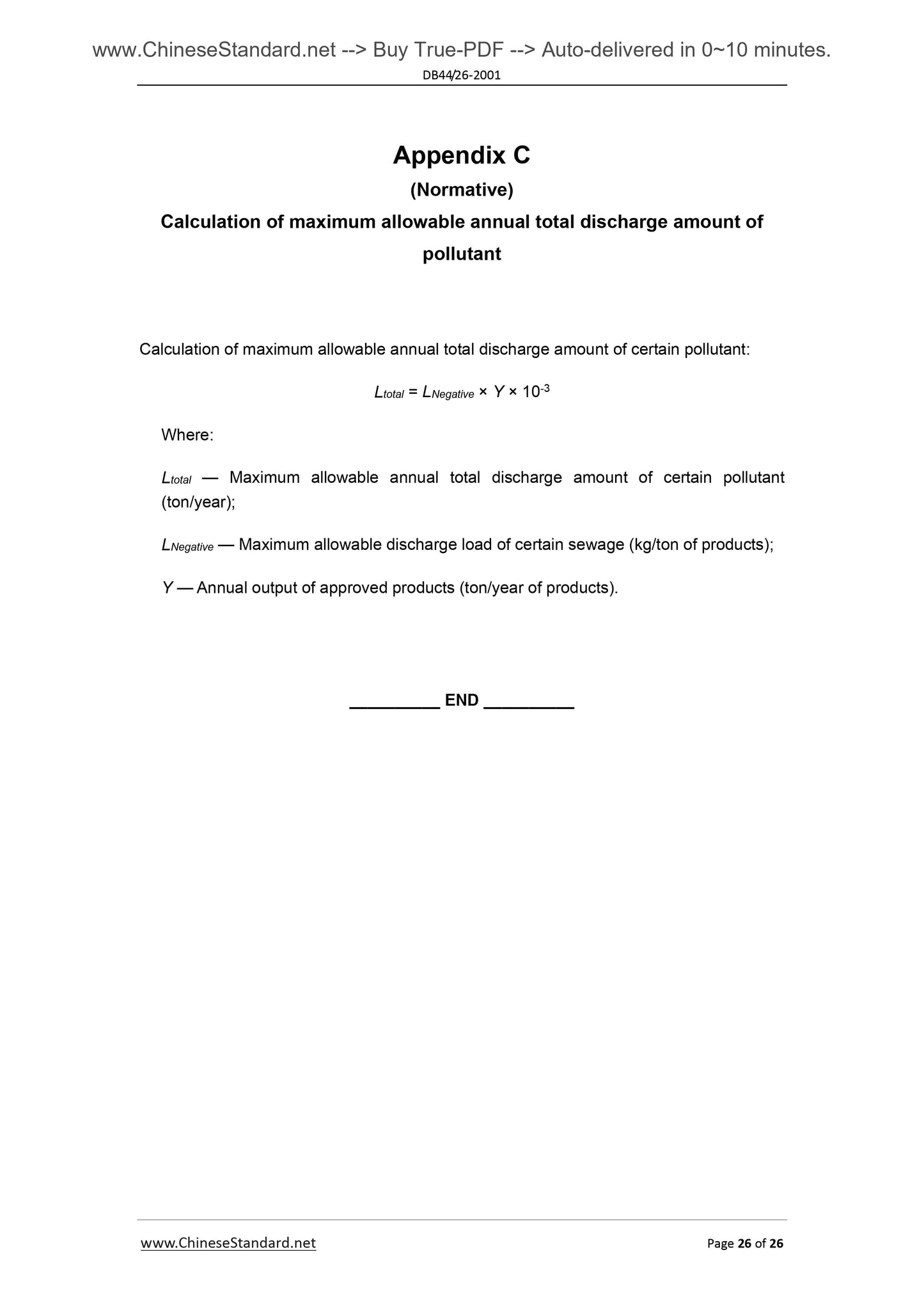1
/
su
12
PayPal, credit cards. Download editable-PDF and invoice in 1 second!
DB44/26-2001 English PDF (DB4426-2001)
DB44/26-2001 English PDF (DB4426-2001)
Prezzo di listino
$195.00 USD
Prezzo di listino
Prezzo scontato
$195.00 USD
Prezzo unitario
/
per
Spese di spedizione calcolate al check-out.
Impossibile caricare la disponibilità di ritiro
Delivery: 3 seconds. Download true-PDF + Invoice.
Get QUOTATION in 1-minute: Click DB44/26-2001
Historical versions: DB44/26-2001
Preview True-PDF (Reload/Scroll if blank)
DB44/26-2001: Discharge limits of water pollutants (GuangdDong Provincial Standard)
DB44/26‐2001
DB44
ICS 13.060.30
Z 60
Record number of the General Administration of State Quality Supervision, Inspection and
Quarantine. 11678-2001
LOCAL STANDARD
OF GUANGDONG PROVINCE (P. R. China)
DB 4426-1989 is abolished
Discharge Limits of Water Pollutants
ISSUED ON. AUGUST 20, 2001
IMPLEMENTED ON. JANUARY 1, 2002
Jointly issued by. Environmental Protection Bureau of Guangdong
Province;
Administration of Quality and Technology
Supervision Bureau of Guangdong Province.
Table of Contents
Foreword ... 3
Introduction ... 4
1 Scope ... 5
2 Normative references ... 5
3 Terms and Definitions ... 5
4 Technical Contents ... 6
5 Monitoring ... 8
6 Standard Implementation ... 9
Appendix A ... 24
Appendix B ... 25
Appendix C ... 26
Table 1 Maximum Allowable Discharge Concentration for Pollutants of First Class ... 11
Table 2 Maximum Allowable Discharge Concentration for Pollutants of Second Class ... 12
Table 3 Maximum Allowable Drainage Volume of Some Industries ... 14
Table 4 Maximum Allowable Discharge Concentration for Pollutants of Second Class ... 16
Table 5 Maximum Allowable Drainage Volume of Some Industries ... 19
Table 6 Analytical method ... 22
Foreword
All technical contents in this Standard are mandatory requirements.
This Standard is the revision to DB 4426-1989 Discharge Standard for Water Pollutants.
Compared with DB 4426-1989, the major changes of this Standard are as follows.
— It is prepared according to requirements of GB/T 1.1-2000;
— Clarify the scope of application;
— Add terms and definitions;
— Adjust the control zone division and standard grading;
— Adopt annual restrictions;
— In Phase I (the first time-period), 16 new controlling items are added; and the
standard values of the previous items are basically maintained at Level 1 and 2
standard values of the previous standard. In Phase II (the second time-period), 46
new controlling items are added; the maximum allowable discharge concentration of
chromaticity, biochemical oxygen demand for suspended solids, chemical oxygen
demand, petroleum, animal and vegetable oils, ammonia nitrogen, and other items
are appropriately to be stricter;
— Add the supporting monitoring requirements and analytical methods.
Appendix A, B and C of this Standard are normative.
This Standard was proposed by Guangdong Environmental Protection Bureau.
This Standard was approved by the People's Government of Guangdong Province.
This Standard was drafted by. Guangdong Environmental Protection Monitoring Station.
The main drafters of this Standard. Liu Jun, Liu Yangzhen, and Liang Zhiguang.
This Standard was first-time issued in 1989; and this is the first revision.
Introduction
In order to control the water pollution; protect the water quality; guarantee the human health;
maintain the ecological balance; and promote the economic and social development, this
Standard is drafted with consideration of the actual situation in Guangdong Province,
according to the Environmental Protection Law of the People's Republic of China; Water
Pollution Prevention and Control Law of the People's Republic of China; Marine Environment
Protection Law of the People's Republic of China; and other relevant provisions.
This Standard replaces DB 4426-1989 Discharge Standard for Water Pollutants.
Since the implementation date of this Standard, DB 4426-1989 shall be abolished.
Discharge Limits of Water Pollutants
1 Scope
This Standard stipulates the discharge limits of 74 water pollutants, in year-limit; and also
stipulates a variety of requirements in the implementation standard.
This Standard is applicable to Guangdong Province’s existing units’ [Translator. “unites” is
defined in 3.3 / 3.4 of Chapter 3. However, it should be replaced with “existing
organizations / enterprises”. Hereinafter it is marked as “UNIT/UNITS”] discharge
management of water pollutants from; environmental impact assessment on the
construction project, design, completion and acceptance of environmental protection
facilities for the construction project; and discharge management after acceptance and
production - except those industries such as shipping, shipping industry, offshore
petroleum development industry, aerospace propellant use, weapon industry, sewage
marine disposal engineering.
2 Normative references
The articles contained in the following documents have become part of this Standard
when they are quoted herein. For the dated documents so quoted, all the modifications
(excluding corrections) or revisions made thereafter shall not be applicable to this
Standard. For the undated documents so quoted, the latest editions shall be applicable to
this Standard.
GB 3097 Marine water quality standard
GB 8703 Regulations for radiation protection
GB 12997 Water quality - Technical regulation on the design of sampling programs
GB 12999 Water quality sampling - Technical regulation of the preservation and
handling of samples
GHZB 1 Environmental quality standard for surface water
Technical requirements for completion inspection and acceptance of construction
project environment protection installations (on trial)
74 items and 83 detection and analysis methods are shown Table 6
3 Terms and Definitions
For the purpose of this Standard, the following terms and definitions apply.
3.1
5.2.2 For the routine monitoring on the industrial wastewater, the monitoring frequency
shall be determined according to the production cycle. For production cycle is shorter than
8, the wastewater shall be sampled every 2 hours. For production cycle is longer 8, the
wastewater shall be sampled every 4 hours. Other wastewater sampling. at least twice in
24 hours. The maximum allowable discharge concentration shall be calculated according
to the daily mean value.
5.2.3 The supervision and management of the environmental protection department and
the monitoring of pollution charges can be sampled randomly according to the actual
situation. The maximum allowable discharge concentration shall be calculated according
to one-time concentration.
5.3 Sample collection and storage
5.3.1 Wastewater sample collection shall be consistent with provisions of GB 12997.
5.3.2 Sample storage shall be consistent with provisions of GB 12999.
5.4 Drainage water-volume
The drainage water-volume shall be controlled according to the maximum allowable
drainage water-volume or the minimum allowable water reuse rate. Both are calculated
according to monthly mean value.
5.5 Statistics
The usage amount of raw materials, product yield, etc., of the enterprise shall be based on
the statutory monthly or annual statements.
5.6 Analytical method
The analytical methods of each item are shown in Table 6. The analytical method shall
adopt the national method standard. If there is no national method standard, methods
listed in the footnote of Table 6 can be temporarily used. After the issuance of the national
method standard, it shall be executed.
6 Standard Implementation
6.1 This Standard shall be supervised and implemented by the competent departments of
environmental protection administration of the above-county-level people's government.
6.2 For control zones specified in this Standard, if executing standards of the
corresponding levels cannot guarantee the water environment quality standard of the
functional water area, the prefecture-level-city people’s government can propos...
Get QUOTATION in 1-minute: Click DB44/26-2001
Historical versions: DB44/26-2001
Preview True-PDF (Reload/Scroll if blank)
DB44/26-2001: Discharge limits of water pollutants (GuangdDong Provincial Standard)
DB44/26‐2001
DB44
ICS 13.060.30
Z 60
Record number of the General Administration of State Quality Supervision, Inspection and
Quarantine. 11678-2001
LOCAL STANDARD
OF GUANGDONG PROVINCE (P. R. China)
DB 4426-1989 is abolished
Discharge Limits of Water Pollutants
ISSUED ON. AUGUST 20, 2001
IMPLEMENTED ON. JANUARY 1, 2002
Jointly issued by. Environmental Protection Bureau of Guangdong
Province;
Administration of Quality and Technology
Supervision Bureau of Guangdong Province.
Table of Contents
Foreword ... 3
Introduction ... 4
1 Scope ... 5
2 Normative references ... 5
3 Terms and Definitions ... 5
4 Technical Contents ... 6
5 Monitoring ... 8
6 Standard Implementation ... 9
Appendix A ... 24
Appendix B ... 25
Appendix C ... 26
Table 1 Maximum Allowable Discharge Concentration for Pollutants of First Class ... 11
Table 2 Maximum Allowable Discharge Concentration for Pollutants of Second Class ... 12
Table 3 Maximum Allowable Drainage Volume of Some Industries ... 14
Table 4 Maximum Allowable Discharge Concentration for Pollutants of Second Class ... 16
Table 5 Maximum Allowable Drainage Volume of Some Industries ... 19
Table 6 Analytical method ... 22
Foreword
All technical contents in this Standard are mandatory requirements.
This Standard is the revision to DB 4426-1989 Discharge Standard for Water Pollutants.
Compared with DB 4426-1989, the major changes of this Standard are as follows.
— It is prepared according to requirements of GB/T 1.1-2000;
— Clarify the scope of application;
— Add terms and definitions;
— Adjust the control zone division and standard grading;
— Adopt annual restrictions;
— In Phase I (the first time-period), 16 new controlling items are added; and the
standard values of the previous items are basically maintained at Level 1 and 2
standard values of the previous standard. In Phase II (the second time-period), 46
new controlling items are added; the maximum allowable discharge concentration of
chromaticity, biochemical oxygen demand for suspended solids, chemical oxygen
demand, petroleum, animal and vegetable oils, ammonia nitrogen, and other items
are appropriately to be stricter;
— Add the supporting monitoring requirements and analytical methods.
Appendix A, B and C of this Standard are normative.
This Standard was proposed by Guangdong Environmental Protection Bureau.
This Standard was approved by the People's Government of Guangdong Province.
This Standard was drafted by. Guangdong Environmental Protection Monitoring Station.
The main drafters of this Standard. Liu Jun, Liu Yangzhen, and Liang Zhiguang.
This Standard was first-time issued in 1989; and this is the first revision.
Introduction
In order to control the water pollution; protect the water quality; guarantee the human health;
maintain the ecological balance; and promote the economic and social development, this
Standard is drafted with consideration of the actual situation in Guangdong Province,
according to the Environmental Protection Law of the People's Republic of China; Water
Pollution Prevention and Control Law of the People's Republic of China; Marine Environment
Protection Law of the People's Republic of China; and other relevant provisions.
This Standard replaces DB 4426-1989 Discharge Standard for Water Pollutants.
Since the implementation date of this Standard, DB 4426-1989 shall be abolished.
Discharge Limits of Water Pollutants
1 Scope
This Standard stipulates the discharge limits of 74 water pollutants, in year-limit; and also
stipulates a variety of requirements in the implementation standard.
This Standard is applicable to Guangdong Province’s existing units’ [Translator. “unites” is
defined in 3.3 / 3.4 of Chapter 3. However, it should be replaced with “existing
organizations / enterprises”. Hereinafter it is marked as “UNIT/UNITS”] discharge
management of water pollutants from; environmental impact assessment on the
construction project, design, completion and acceptance of environmental protection
facilities for the construction project; and discharge management after acceptance and
production - except those industries such as shipping, shipping industry, offshore
petroleum development industry, aerospace propellant use, weapon industry, sewage
marine disposal engineering.
2 Normative references
The articles contained in the following documents have become part of this Standard
when they are quoted herein. For the dated documents so quoted, all the modifications
(excluding corrections) or revisions made thereafter shall not be applicable to this
Standard. For the undated documents so quoted, the latest editions shall be applicable to
this Standard.
GB 3097 Marine water quality standard
GB 8703 Regulations for radiation protection
GB 12997 Water quality - Technical regulation on the design of sampling programs
GB 12999 Water quality sampling - Technical regulation of the preservation and
handling of samples
GHZB 1 Environmental quality standard for surface water
Technical requirements for completion inspection and acceptance of construction
project environment protection installations (on trial)
74 items and 83 detection and analysis methods are shown Table 6
3 Terms and Definitions
For the purpose of this Standard, the following terms and definitions apply.
3.1
5.2.2 For the routine monitoring on the industrial wastewater, the monitoring frequency
shall be determined according to the production cycle. For production cycle is shorter than
8, the wastewater shall be sampled every 2 hours. For production cycle is longer 8, the
wastewater shall be sampled every 4 hours. Other wastewater sampling. at least twice in
24 hours. The maximum allowable discharge concentration shall be calculated according
to the daily mean value.
5.2.3 The supervision and management of the environmental protection department and
the monitoring of pollution charges can be sampled randomly according to the actual
situation. The maximum allowable discharge concentration shall be calculated according
to one-time concentration.
5.3 Sample collection and storage
5.3.1 Wastewater sample collection shall be consistent with provisions of GB 12997.
5.3.2 Sample storage shall be consistent with provisions of GB 12999.
5.4 Drainage water-volume
The drainage water-volume shall be controlled according to the maximum allowable
drainage water-volume or the minimum allowable water reuse rate. Both are calculated
according to monthly mean value.
5.5 Statistics
The usage amount of raw materials, product yield, etc., of the enterprise shall be based on
the statutory monthly or annual statements.
5.6 Analytical method
The analytical methods of each item are shown in Table 6. The analytical method shall
adopt the national method standard. If there is no national method standard, methods
listed in the footnote of Table 6 can be temporarily used. After the issuance of the national
method standard, it shall be executed.
6 Standard Implementation
6.1 This Standard shall be supervised and implemented by the competent departments of
environmental protection administration of the above-county-level people's government.
6.2 For control zones specified in this Standard, if executing standards of the
corresponding levels cannot guarantee the water environment quality standard of the
functional water area, the prefecture-level-city people’s government can propos...
Share
